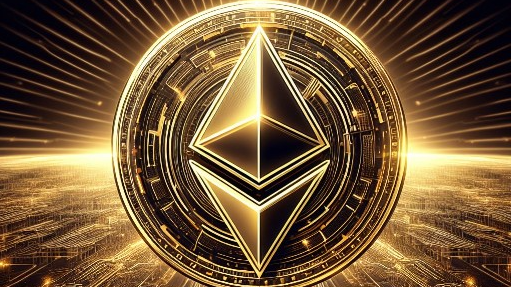10 months ago
What is Ethereum, and How Does it Work?

In the intricate tapestry of the digital realm, a question often bubbles up to the surface — what is Ethereum? What is an Ethereum crypto coin? This query isn’t just a fleeting thought but a reflection of the growing curiosity surrounding this blockchain behemoth.
As we peel back the layers, we unveil a world where technology and innovation intertwine, painting a masterpiece of possibilities that stretch beyond the ordinary. So, let’s dive in and unravel the enigma that is Ethereum.
Ethereum and Its Purpose
It, at its core, is a blockchain-based platform that breathes life into decentralized applications (dApps) and smart contracts.
But what is Ethereum in simple terms? Imagine a world where intermediaries take a back seat, and transactions, agreements, and applications run seamlessly without needing a middleman.
That’s the world is carving out, a world powered by its native crypto coin, Ether.
So, what is Ethereum actually used for today? It’s the fuel that powers a decentralized machine that’s rewriting the rules of engagement in the financial sector, gaming industry, and beyond. It’s known for bringing smart contracts into the limelight, a technology that’s not just a buzzword but a revolution in making transactions secure, fast, and transparent.
History and Origin
What is the meaning of Ethereum? The world's genesis can be traced back to 2013 when the digital space was ripe for a transformation. Vitalik Buterin, a prodigy and visionary, saw beyond the limitations of Bitcoin and dreamt of a landscape where blockchain could be used for more than just cryptocurrency transactions.
It was his brainchild, a platform where developers could build and deploy many applications, unshackled by the constraints that held back innovation. In 2015, this dream materialized, and Ethereum sprang into existence, not just as another cryptocurrency but as a catalyst for the decentralized revolution.
What Is a Smart Contract?
In Ethereum, the term ‘smart contract’ is as ubiquitous as the air we breathe. But what is it, exactly? A smart contract is self-executing, with the words directly written into lines of code. It’s an agreement that doesn’t just sit on paper but is ingrained in the blockchain, executed automatically when predefined conditions are met.
What is Ethereum good for, if not for being the pioneer in making these smart contracts a household name? These aren’t just lines of code but are the building blocks of a trustless ecosystem where agreements are immutable, transparent, and secure.
Real-World Use Cases of Smart Contracts
Smart contracts do more than just change the narrative; they transform real-world operations. In finance, they’re automating transactions and cutting down the red tape. In supply chain management, they’re ensuring transparency and traceability. Every sector, from healthcare to entertainment, is getting a taste of this innovation.
So, what is Ethereum known for? It’s known for being the harbinger of a world where smart contracts and decentralized applications reign supreme, a world where the traditional systems of operation are not just challenged but reinvented.

Ethereum Virtual Machine (EVM)
As we delve deeper into the ecosystem, we encounter a pivotal component that stands as the backbone of this innovative platform — the Ethereum Virtual Machine (EVM). But what role does the EVM play, and how does it fit into the grandeur of Ethereum’s architecture?
The EVM is a quintessential element, a robust runtime environment that breathes life into smart contracts and decentralized applications (dApps). It’s akin to a ship's engine room, powering and propelling the vessel through the vast digital oceans. In the context of Ethereum, the EVM ensures that dApps and smart contracts are executed efficiently, securely, and without interference.
How EVM Enables the Running of Decentralized Applications (dApps)?
In a world where the question, “What is Ethereum doing?” echoes, the EVM is a testament to the platform’s versatility and innovation. It’s the space where code transforms into action, where smart contracts and dApps leap from abstraction to concrete reality. Every operation, transaction, and execution within the Ethereum ecosystem is made possible by the EVM’s robust architecture.
Ether as the Native Cryptocurrency of the Ethereum Platform
As we pivot our focus to Ether, the native cryptocurrency, we unveil another layer of Ethereum’s multifaceted ecosystem. What is Ethereum known for? Ether isn’t just a digital coin; it’s the lifeblood that fuels the operations within the Ethereum network. From executing intelligent contracts to facilitating transactions and powering dApps, Ether is the currency that keeps the wheels of innovation turning.
Challenges and Criticisms
Yet, like any groundbreaking technology, it is not without its challenges. Scalability has been a thorn in its side, a hurdle that sometimes slows down the pace of transactions and operations. As the network burgeons, the question of how to scale effectively and efficiently remains.
Environmental impact, particularly the energy consumption associated with mining, is another criticism that often surfaces. The energy-intensive mining process has come under scrutiny in a world increasingly conscious of its ecological footprint.
Solutions and Improvements
But Ethereum is not a static entity; it’s an evolving, responsive, and adaptive platform. Ethereum 2.0 heralds a new dawn, a shift from the energy-intensive proof-of-work to a more sustainable and scalable proof-of-stake consensus mechanism. This transformation is not just a leap but a quantum jump toward addressing the scalability concerns and reducing the environmental impact.
As we anticipate the full rollout of Ethereum 2.0, we see a platform that’s not just resting on its laurels but is relentlessly pushing the boundaries, addressing criticisms, and evolving to meet the demands of an ever-changing digital landscape.
In Retrospect
So, when the question, “What is Ethereum in blockchain cryptocurrency?” arises, the answer lies not just in its innovative technology, smart contracts, or dApps, but also in its adaptability, resilience, and unyielding pursuit of excellence. Ethereum is not just a cryptocurrency or a platform; it’s a living entity, growing, evolving, and adapting, poised to lead the decentralized revolution into a future unfettered by limitations and ripe with limitless possibilities.
As we pull the curtains on this exploration, the essence of Ethereum stands unveiled. It’s more than just a crypto coin; it’s a movement, a revolution redefining the meaning of transactions, contracts, and applications. Ethereum is doing more than just existing; it’s thriving, evolving, and leading the charge toward a decentralized future where the power is truly in the people's hands.
So, when next, you ponder, “What is Ethereum in blockchain cryptocurrency?” remember, it’s the silent force propelling us into a future where technology, innovation, and security converge into an ecosystem of endless possibilities.
FAQs
Is Ethereum Real Money?
It is not real money in the traditional sense, as it's neither a physical currency nor issued or regulated by any central authority or government. However, a digital or virtual currency, specifically a cryptocurrency, holds real value and can be used to make transactions, invest, or be exchanged for fiat currencies.
Can You Convert Ethereum to Cash?
Yes, you can convert Ethereum to cash. Ethereum can be sold on various cryptocurrency exchanges, and the proceeds can be withdrawn to your bank account. There are also crypto ATMs that can convert the crypto to cash instantly, and some platforms offer prepaid cards that can be loaded with cryptocurrencies and used like a regular debit or credit card.
What is the Biggest Risk to Ethereum?
The most considerable risk to this crypto lies in security and scalability. Security concerns revolve around potential vulnerabilities in smart contracts and the broader Ethereum network that malicious actors could exploit. Scalability issues pertain to the network’s ability to handle many transactions quickly and efficiently as the user base grows.
Who Controls the Most Ethereum?
There isn't a single entity or individual that controls the most Ethereum, given its decentralized nature. Ethereum is held by a diverse group of individuals, organizations, and investors globally. The distribution is relatively widespread, although large holders, often called "whales," own significant amounts of Ethereum.
Why Do People Use Ethereum Instead of Bitcoin?
People use ETH instead of Bitcoin for its additional functionalities beyond being a digital currency. The cryptocurrency enables the creation and execution of smart contracts and decentralized applications (dApps), offering a broader range of uses, including decentralized finance (DeFi), gaming, and more. It's a cryptocurrency and a platform for innovation and development in the blockchain space.
Industry analysis
How are Cryptocurrency Hot Wallets Different from Cold Wallets
What is USDT — Tether coin meaning in cryptocurrency
How to Buy and Invest in Bitcoin
Cryptocurrency Security in 2024
Difference Between CEX and DEX in Crypto
What Is a Crypto Exchange
The Biggest Crypto Scams of All Time
Difference Between a Crypto Exchange And Broker
Accounting for Cryptocurrencies
Types of Cryptocurrency Wallets
Stay informed about the latest news on crypto
Subscribe to our newsletter.








